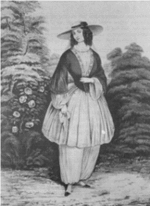 |
| Mary Cassatt, Mother and Child, 1990 |
The ideology of women belonging in the kitchen stems from the lack of opportunity that they were exposed to in Europe during the middle ages. In Europe, during the middle ages, women were taking the roles of wife, mother, peasant, artisan, and nun. During the early middle ages, that’s when roles within the Church became available to women. Regardless of women being able to take on various roles in their lifetime, they had to sacrifice a leg and an arm just to get to where they desired. Women were often oppressed and marginalized, given few opportunities to flourish because they were trapped within a patriarchal structure. In Whitney Chadwick’s, Women, Art, and Society, she states, “Within the convent women had access to learning even though they were prohibited from teaching by St.Paul’s caution that “a woman must be a learner, listening quietly and with due submission. I do not permit a woman to be a teacher, nor must a woman domineer over a man; she should be quiet”” (Chadwick 45). Everything women did, it was expected of them that they did it within the realm of male dominance. The expectations of women were bizarre and overtly sexist as it consisted of: marrying and having kids rather than a career, weren’t permitted in the political process, work limited, and their designated place to be at home.
 |
| The rise of bloomers that relates to Amelia Jenks Bloomer |
Having been that the expectations of women were bizarre and overtly sexist, the roles for women slowly, but surely, changed throughout the renaissance and into the 19thcentury. The oppression of women led leading roles in the feminist movement. The first-feminist movement occurred within the 19thand early 20thcenturies. During this time, it was urged to gain women’s right to vote. Althought things were unjust and women were fighting for equality, they faced strong resistance. Women who wanted to become artists had to fight to be taken seriously because those who were seeking careers in the fine arts were given few opportunities when being compared to men. Often times, there were many general limitations for women when it came to artistic training. They were excluded from viewing nude models, so they weren’t able to practice the fundaments of art. In Guerilla Girls’, The Guerilla Girls’ Bedside Companion to the History of Western Art, they state, “At the same time, male painters began to obsess over and objectify the naked body as never before” (Guerilla Girls 47). Many women’s rights advocates wanted to claim their sexual activity. The idea that women were so largely forbidden to pursue art, having them at the center of an art piece, seems insulting and contradicts the Christian ethics that were prominent during the middle ages. Chadwick states, “While women’s social roles remained circumscribed by a Christian ethic that stressed obedience and chastity…” (Chadwick 44). How is it that women are expected to be chaste, but they’re put in situations that is far from chaste? But if and when a female artist was to be successful, they were usually associated with successful male artists as their pupils, models, or daughters. An example being Mary Cassatt. She was an American painter whose artwork was respected and admired by a club of Impressionist who were almost all male. She was granted this opportunity because she was the daughter of a wealthy industrialist. During the 19thcentury, women were allowed to enter the public sphere for the first time. Instead of being restrained in the confides of their home, they were allowed to step out because 19thcentury feminists didn’t disregard the need for working women. Amelia Jenks Bloomer was an American women’s rights advocate. She recognized that for women to participate in economic activities, they needed to be dressed accordingly. Thus came the look of a fitted tunic, trousers and undergarments. Although she did not invent these articles of clothing, she supported its idea. These roles of women influenced the lives of women artists and the subjects of their work because it gave them the ability to be more confident within themselves and their artwork. Women were able to fund their own art since they’re exposed to education. The fight for equality between the sexes has always been evident and the world of artisans just goes to prove how something that can be seen as so feminine, is still male dominant.
Works Cited
The Guerrilla Girls' Bedside Companion to the History of Western Art. Penguin Books, 2006.
crashcourse. “Women in the 19th Century: Crash Course US History #16.” YouTube, YouTube, 23 May 2013, www.youtube.com/watch?v=fM1czS_VYDI.
“Amelia Bloomer.” Wikipedia, Wikimedia Foundation, 13 Sept. 2018, en.wikipedia.org/wiki/Amelia_Bloomer.
Learning, Lumen. “Sociology.” Lumen, courses.lumenlearning.com/alamo-sociology/chapter/reading-the-womens-movement/.
“Women in the Middle Ages.” Wikipedia, Wikimedia Foundation, 5 Oct. 2018, en.wikipedia.org/wiki/Women_in_the_Middle_Ages.
Chadwick, Whitney. Women, art, and society. Londres: Thames & Hudson, 2012. Print.
No comments:
Post a Comment